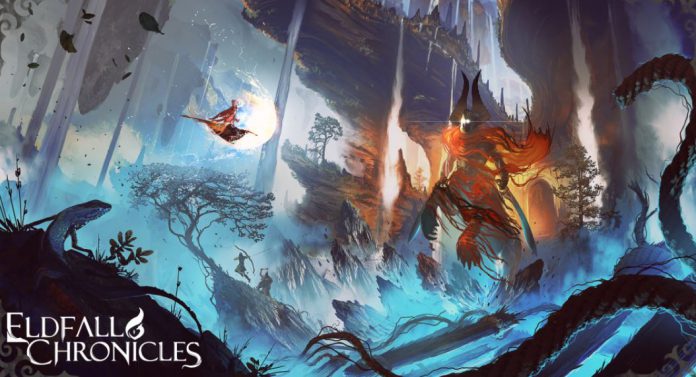
The Sand Kingdoms is a relatively unique faction in Eldfall: every single model has access to some form of magic! What type of magic varies from model to model, but each has potent capabilities to offer up. In this article we’ll review the models of the Eldfall Chronicles core set for the Sand Kingdoms and give you an idea of their capabilities and how they might be used to accomplish your quests.
General recruitment strategies
Sand Kingdoms parties have a few routes to go in terms of their construction. As the Vizier of Conjurations is almost certain to be your leader you’ll already have access to spare disposable models, but most of the faction-specific models are relatively squishy themselves. For this reason, you may want to consider splashing into semi-affiliated or Neutral models to give your team a bit more durability for direct conflicts. This can also allow your spellcasters to breathe a little easier, as the opposing models are likely going to have their hands full dealing with someone charging their ranks and elemental beasts looking to claw their throats out. Alternatively, you can lean into the flexibility of magic and go with the flow–your default 3-4 model party is going to have a combination of enchantment, sorcery, wizardry, and/or summoning that is almost always going to have a useful application at any given time.
Another faction-specific capability is changing/adding magic affinities. Any model can have their magic affinity switched out for or expanded to include an elemental power for either 1pt or 4pts, using Mana Catalyst or Elemental Lineage respectively. Please note that as it stands the rules for elemental magic are limited and only Fire Sorcery is really fleshed out in a meaningful way, but it’s good to consider as an option and keep an eye out as the game system grows. You might want to try this out just to switch things up or take multiples of one spellcaster and branch into additional powers to open up a new arsenal of tricks.
Sand Kingdoms models
Since there’s a wide variety of magic available in this game system, not only will we take a look over the model rules itself but we will explore each models default spells and discuss their application. Each of these models have an Affinity to a type of magic which is listed in the rulebook as well as Survival (Scorching) trait to illustrate their experience with living in the baking sands of the desert.
Academy Expeditioner
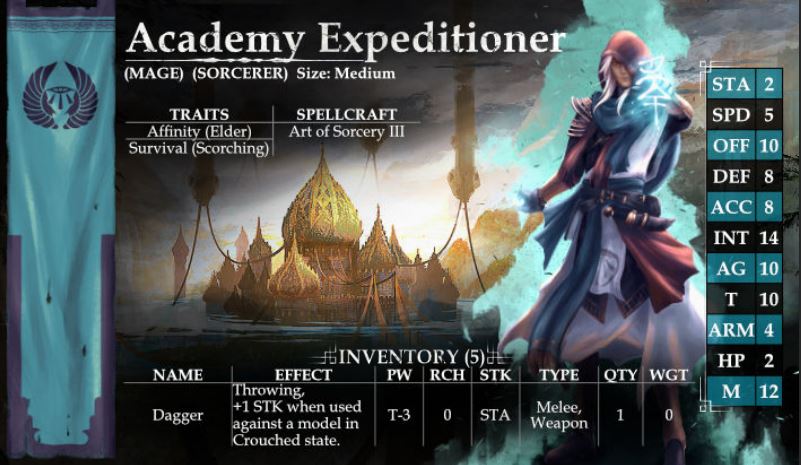
This model offers up firepower for your party, specializing in eldritch direct damage spells. As a MAGE and SORCERER, the Expeditioner is capable of accurately casting their attack magic as they get an innate re-roll to one failed spellcast and, if they absolutely need to, can spend an activation point to re-roll another die or that same failed roll again. With Intellect 14 it’s not likely you’ll fail your casts often, but it’s nice to know that there’s some level of certainty here.
As this model is expected to be running and gunning a bit, it helpfully has a decent amount of armor and 2HP so it can see some direct action without hitting the floor immediately. If you’re looking to be less discrete with your gameplay bringing two of these along isn’t necessarily a bad plan, especially if you learn into their durability and pay for the Additional Protection upgrade.
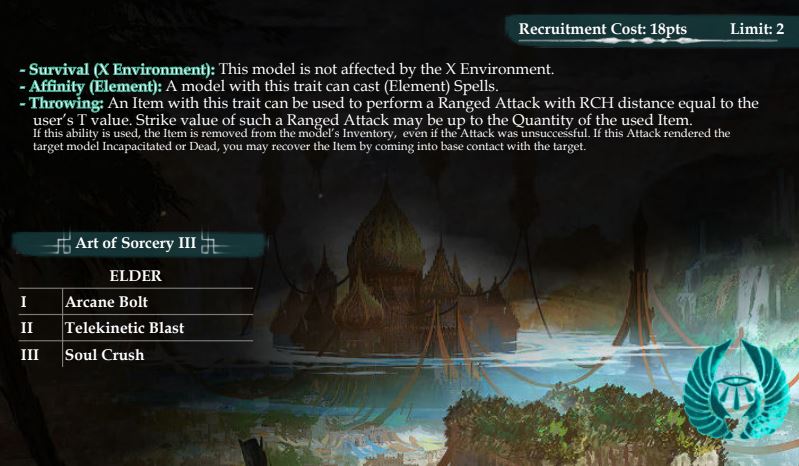
Elder Sorcery spells
Arcane Bolt: Launches a number of magic missile attacks equal to the casters Stamina at a reach of 16″ and power equal to their Intellect, and on a critical success these attacks also have the Knockdown trait. A bread-and-butter attack that’s not particularly powerful or interesting but you can throw enough attacks that something will probably land.
Telekenetic Blast: A large spray template attack, used to scatter/disrupt clustered targets. The Knockback (3) effect of this spell occurs so long as the attack hits, and allows the spellcaster to direct the affected models 3″ in any direction so long as they end further from the model than they started. This also puts targets into the Crouched state, which can be helpful for Sand Kingdoms members armed with daggers and ready for some stabbin’. It has more utility in higher point-value games, but it’s nice to have in your back pocket for when you might be able to force targets off ledges/into the open for other party-members to react to.
Soul Crush: A single targeted attack with a reach of 16″, Soul Crush (as the name implies) inflicts spiritual damage and bypasses any armor they may be wearing. This can be hugely powerful in the right circumstances, either against well-armored enemy player models or the rampaging elemental hostiles that are armored like tanks. Provided the target suffers a wound, they must then make a Toughness check to not immediately lose their activation points for their reactions this turn and, worse still, they become Panicked and have to make a Morale test each time they want to perform an action. Come for the strong offensive ability, stay for watching your opponent run screaming from the field.
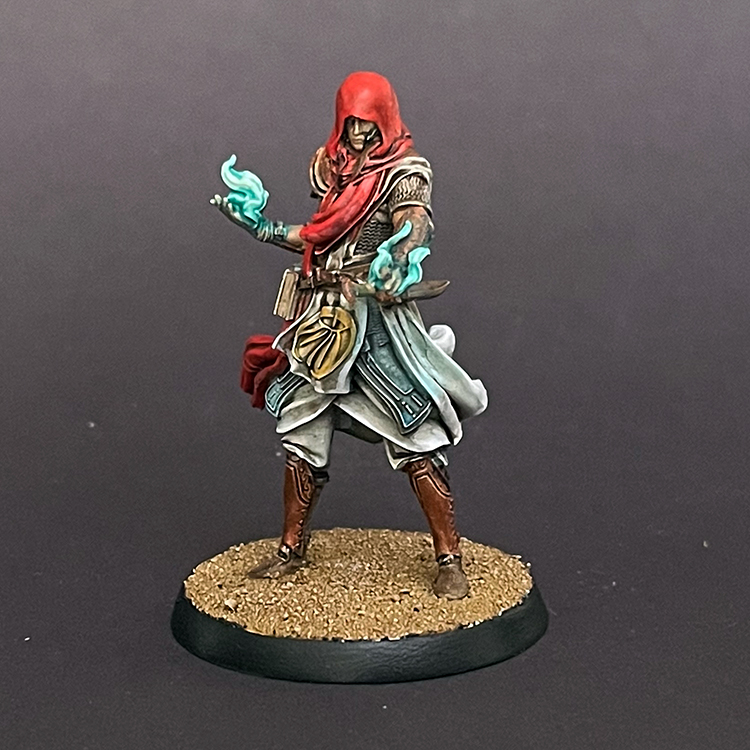
Faris Outrider

Using enchantments to increase their own power, the Faris Outrider uses its speed and ability to cut through armor as a means to put the opponent on bad footing. As an ARTIFICER, during its players Strategic phase the model can elect to place on enchantment on itself that lasts a full round without making a roll. This makes planning your next move easier, which is generally going to be to engage targets of opportunity.
Offensively this model has a fantastic combination of Stealth, Arcane Lantern (which reveals hidden targets and means its never surprised), and Follow-Up that allows it to make a half-move toward a target that tries to escape it. This means if the Outrider becomes engaged with any model and it tries to dodge away, they can match the retreat speed for free and continue to lock the model in combat. Better still, as a ROGUE, the Outrider can proc Knockdown with its hits, making additional attacks with its dagger that much more deadly. Especially in combination with Spectral Blade this exhausting flurry of footwork and attacks can drain foes of their ability to continue.
If you’re going the speedy-killer route don’t just throw this guy into combat without purpose–there are obviously going to be models where this guy is going to be out-matched in a direct assault, but used to pick off support models and keep people on their toes they can be extremely useful and dangerous. Bear in mind that properly defended, this model can use a special movement to Taunt and draw out activations before it engages.
The main focus for this model is for self-enhancement, but it is possible to use the enchantments of this model to support other characters. This can be helpful to support your faction models caught in a pinch (especially Arcane Shield) or enhance the defense and/or offense of hired non-Sand Kingdoms models. If you splash out into non-SK enough it’s possible to just have this guy hang back as a source of magical support while other models run wild.

Elder Enchantments
Arcane Shield: Halves the Power of any attack against the target, making it far less likely to inflict damage. Useful for protecting your models caught in a bad situation and great in combination with well-armored non-SK models. Imagine a shielded hired-blade Onitaoshi just wading through battle, any non-critical hit with Power 12 or less automatically failing…
Spectral Blade: The models gains Ignore Armor and Stagger, making their attacks bypass armor altogether as if they were a critical hit, and also (likely more importantly) any successful hit removes an activation point from the target of the attack. Models affected by this can quickly drain the opposing team of the ability to react. Very, very useful even for a party only armed with daggers, but (see the trend here) non-SK models can become offensive powerhouses.
Hasten: Allows the model to make a normal move action during the Strategic phase of each turn. For other models, applying this will allow it to move once during the enemy Strategic phase (unless you’re fighting multiple opponents where it can get silly). For the ARTIFICER Outrider, applying this to itself allows it to immediately make a move in the current phase and then additionally in the enemy phase, basically giving it 10″ of free movement without fear of reactions. Simple and powerful.
Taskmage Explorer

A support-utility character with some basic offense sprinkled in, the Taskmage Explorer has access to a wide variety of spells (the second-largest selection in the current rules). Similar to the Academy Expeditioner above, this model is able to use its combination of MAGE and WIZARD to re-roll one failed Elder spell for free and potentially re-roll another (or the same failed re-roll) at the cost of an activation point.
Aside from noting that this is a stereotypically fragile spellcaster, there’s not a whole lot to discussed about the model itself. They do have some utility when it comes to stealth/revealing stealth, but their main selling point is as a platform for the spells it keeps in its brain. Up for hire, this model can help supplement parties looking for a magical edge. Keep them in range for supporting your party and out of harms way and the Taskmage will make sure you’ve always got something for the job.

Elder Wizardry spells
Mana Burst: The only offensive spell available in Elder Wizardry, this is a targeted direct damage spell with a reach of 16″ and Stagger. Great for knocking the wind out of opponents, damage or no.
Dispel Magic: The spellcaster selects from a list of available options and apply the effect on all models in a large AOE template centered anywhere within 16″. This can remove a sorcery/enchantment/transmutation*, remove a summoned model*, or cancel the Shrouded state. Considering what trouble summoned models can be and where they might be located at the time this is used, this can be key to ruin a Summoners well-laid plans.
* There’s a bit of wording here that probably needs to be clarified, as the AOE spell removes a “target” spell or summoned creature and this could either be interpreted as “a single specific targeted spell/creature” or a “target” type of spell/creature by name, such as Hasten or Gargoyle. If more than one exists in the same AOE space, the former would mean only one would be removed and the latter would clear all valid targets. As it’s an AOE and multiple enchantments/summons of the same type in the same space would be extremely rare (and foolish if the player knew what was good for them), I’d probably read it as the latter.
Confuse Target: A solid short-term debuff against an enemy model, this spell cannot be easily dodged thanks to Mindgame requiring the check be made using Intellect instead of Agility. Confuse Target (surprise) causes the target to become Confused until the end of the turn, halving a ton of vital attributes and making them much more susceptible to other attacks/abilities in your following activations.
Ward: A very clutch reactive Assist-action sorcery that causes all non-critical damage within a 16″ reach (or self-only in melee) during an activation to be negated. As a sorcery the duration of this spell is only the specific model activation sequence, so this only zeroes out a single models attack results for one activation. That said, there are some models that can put in a huge number of attacks/damage in one go so there’s some real value here. The key is that in order to make a react action, the caster must see both the attacker and the model they’re looking to ward. This might call for some tricky positioning and/or put the spellcaster in danger, but there’s much less to think about if the target of the spell is the spellcaster themselves.
Redirect Damage: Another reactive Assist spell. The wording on this one is a bit wild, but the result is what the name implies: this spell causes non-critical damage from an attack to be negated on its intended target and is instead applied (along with any traits or special rules) onto the attacker. Considered a direct single-target spell, its mentioned in the spell description that this isn’t an “attack” that might potentially hit an ally entangled in ongoing close combat. The spellcaster does need to be within the 16″ reach and have both targets visible, but it can have significant impact if it goes off against an aggressor who can dish it out but can’t take it.
Hastened Recovery: An Assist spell which is valuable in either turn, Hastened Recovery can remove one of a number of different status effects or heal 1HP on a single target within 16″. Simple and effective, this can keep your party topped off or even revive incapacitated models.
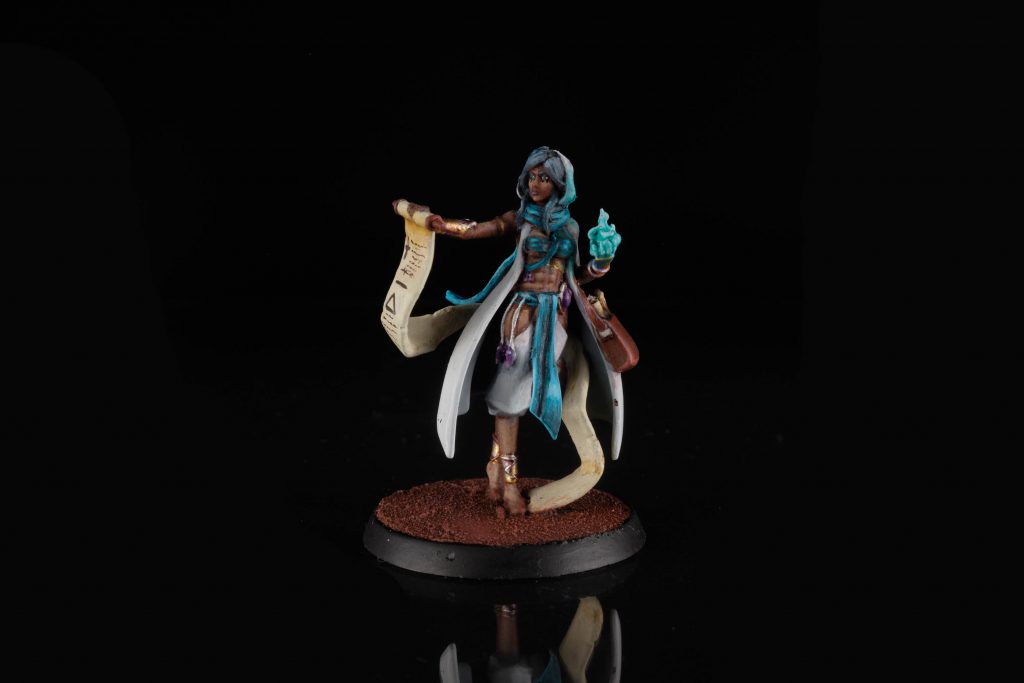
Vizier of Conjurations

The leader and magical heart of a Sand Kingdoms party, the Vizier of Conjurations supplements your available models with one or more disposable elemental summons. These summoned creatures are all useful and dangerous allies at your disposal, and learning to select the right type(s) and keep your frail Vizier alive are going to be critical to your party’s success.
Unlike every other leader, the Viziers stratagems will only affect itself (at least for now). You have two choices to select from, each of which improve your model to summon more or stronger creatures. Temporary Bind knocks the Mana Upkeep of a target summoned creature to 0 for the turn and will likely allow you to fit in another summon even if your Mana Upkeep is technically at or exceeds your Stamina. Refined Conjuration reduces the Mana Cost of a conjuration action by 1, making Gargoyles (or Imps, if you really want?) free to summon and those bigger models more affordable.
As a SUMMONER, the Vizier of Conjurations can (and should) start the game with either a Tier I or II creature already in its control without spending any resources. It’s almost a certainty that you’re going to want to spend for upgrades here, as many of the Sand Kingdom upgrades are direct improvements to your Vizier and their minions. As long as you’re planning on having two or more summons, Conjured Retinue is essentially a must-take unless you’re really strapped for points; granting SOLDIER to all Tier I/II creatures is a strong force multiplier for very little cost up-front.
The currency of conjuring (and other larger special spells for MAGE models) is Mana, which your model will start without. To generate Mana, they will need to spend an Activation point (doing so doesn’t count as an activation and won’t trigger reactions) on a 1-for-1 basis. This means, if you have your eye on a Tier III/IV creature, you’re doing to be powering up Dragonball-style in the background for a turn or two before you’ll be able to put your monster on the table. Considering the “short” amount of game time and the fact that some models can just dispel summons out of hand, it’s probably recommended you stick with Tier I/II models to get into the game quickly and put pressure on enemy parties but both the Earth Elemental and the Colossus are beastly and worth reviewing to see if they fit in your plan.
Probably the “best” first-turn combination here would be to either have your Vizier come onto the table with a Golem and summon a Gargoyle for 1 Mana (after using the stratagem to make the Golem count as no upkeep), or start with a Gargoyle and summon a second for free by reducing the Mana Cost to 0. Starting with two extra models on the field is going to give you a huge amount of extra activations and will allow the creatures to buff each other via SOLDIER (which we can only assume you took the upgrade for because why wouldn’t you?). Gargoyles are speedy and no slouches in combat and have the horrific ability to steal activation points from targets, so enemy models can quickly get mauled if they’re not careful.
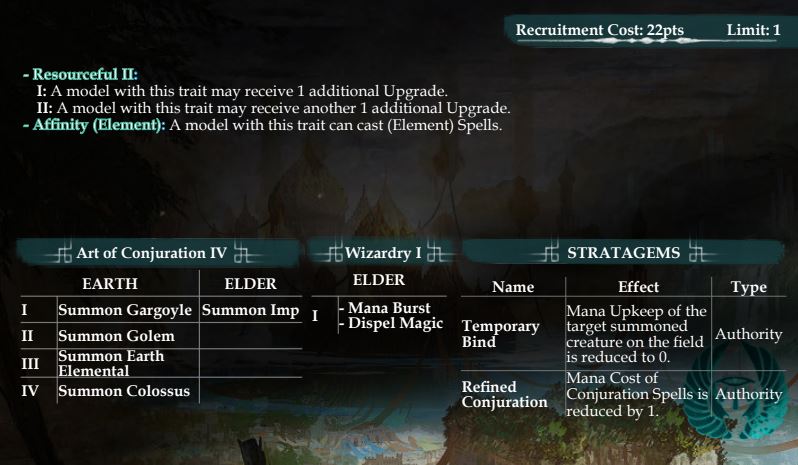
Art of Conjuration spells
We’re going to cover a general summary of the available summoned creatures here, but look for a future article on this subject to review them more in-depth. These creatures are either Constructs or Elementals, both of which ignore a large number of special rules and status effects so be mindful of that (and helpfully remind your opponent if they try to poison your rock golem).
Summon Gargoyle – Mana Cost (1): Your tireless small attack creatures. Fast, well-armored, lethal, and (most importantly) cheap, Gargoyles are going to give enemy models trouble while your other real models set to work. These models can make the most of terrain features using Climbing and Leap skills to move at their full rate while traversing the board. Worst case, they draw out a bunch of enemy reactions and they die tiring the enemy out. Best case, they do that, live, and kill the enemy while you sit around sipping a summoned refreshing beverage.
Summon Golem – Mana Cost (2): A heavily armored and durable construct, the huge Golem boasts 3HP, relatively high Defense, and the Protector skill which allows it to spend a reactive activation point to take a hit for a nearby friendly model (presumably your Vizier but it could be anyone if you’re pushing this brute forward alongside other fighters). It’s not going to do a significant amount of damage overall, but its there to tank hits and it does that well enough to keep one around.
Summon Earth Elemental – Mana Cost (3): The gigantic Earth Elemental is an incredibly durable and dangerous model that is very difficult to kill without committing fully to the act. With Defense 14, Armor 10, 4HP, and Regeneration, this creature is best placed central to the action where it can use its immobilizing Rooting Embrace spell to lock down multiple enemy models (whether it can see them or not) and then declare all aboard the knuckle train to fist planet. If your opponent(s) don’t have a way of quickly eliminating this model, the Watchful trait makes this guy an absolute menace during the reactive turn with FOUR activations. Good stuff all around.
Summon Colossus – Mana Cost (4): You’ve stored up enough energy to bring forth the top of the line in summoned creatures, congratulations! The colossal Colossus is an offensive powerhouse, though not especially subtle. Capable of 3 activations per turn, this monster can crash through models using Trample before it starts hacking people to pieces. Thanks to the Cleave effect on its attacks inflicting 2 wounds instead of 1, any successful damage roll against most models in the game is going to incapacitate or kill them outright. At 6HP and high physical attributes, your opponents models are best to not directly engage with this and hide for dear life, using the terrain to play keep away. Then again with up to 24″ (3 x 8″ run) movement in a single turn, that’s going to be tough.
Summon Imp – Mana Cost (1): This spell summons one of those classic 1990s-internet “under construction” GIFs, as the rules and model for the Imp (as of the time of this publication) do not exist. Don’t cast this spell unless you’re just doing some hilarious flex after trouncing your opponent.
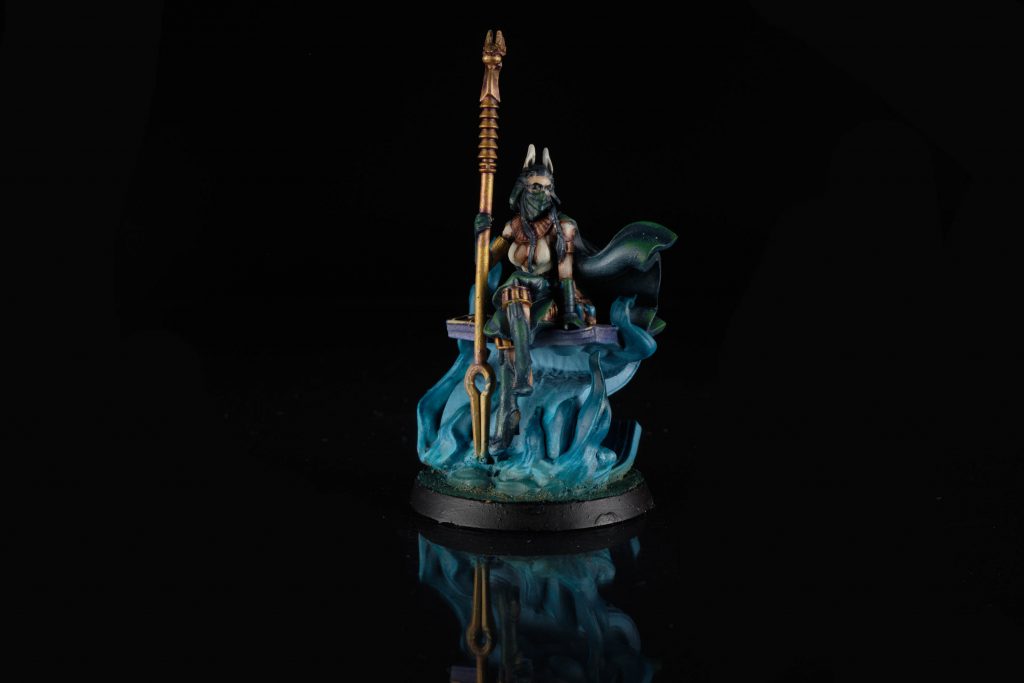
Schemes
With everything else in the faction being somewhat complex, the Sand Kingdom schemes offer up some simplicity and primarily focus on model positioning.
Stalwart Defender rewards you 3VP for keeping opponents away from your deployment area, which (depending on the quest) might be fairly simple so long as you keep a monstrous summon nearby to smash any foolhardy foe.
Appear Weak When You Are Strong rewards VP for sneaking in melee wounds, which may seem relatively tough sans the Faris Outrider but note that this does not exclude your summoned models which will happily beat your targets to death.
Unhindered Expedition and Steadfast Expansion might be a tougher schemes to pull off, as it pushes your party to leave their comfort zone and move outside their deployment and potentially across the board. This depends a good deal on enemy positioning, terrain, etc. and is by no means impossible, but it is going to directly impact your model positioning if you want to score either of them. You only score 1VP for “real” models up to 3VP on either of them, so you’re probably going to want to plan around these early before bodies start dropping.
Strength In Numbers requires you to outnumber your opponent at the end of the game, including summoned models, and is a very easy score so long as you’re not tabled and your Vizier is still kicking. It’s only worth 2VP, which makes scoring VP for other sources more important, but one of the assumptions here is that you outnumber them because you’ve killed models and thus scored VP for that too.
Stand Your Ground scores 1VP for every model that does not to move during the turn which, considering with summons you’ll frequently have more than 3 models available, seems pretty doable. This is especially true if you’ve positioned yourself well to hide or caught your opponent flat-footed for a “then I started blasting” turn. Note that this is scored at the End phase of your turn, so you can still dodge away as reactions later.
Upgrades
Note: A number of Sand Kingdoms upgrades are not going to be especially valuable at the time of this publication, but as the magic catalogue gets fleshed out expect availability of spells and spell levels to get another look.
Mana Catalyst (1pt) – As discussed above, this changes a models affinity to another primary elemental type. Most of these remain limited, so it’s not super-valuable right now.
Elemental Lineage (4pts) – Similar to Mana Catalyst, but adds an affinity instead of replacing it. Similar issue right now, save the points for other things.
Arcane Tome (3pts) – A model has access to the next level of one of its spellcrafts. Every model in the faction are already at max level in their applicable schools except for the Vizier, so there’s limited application here. That said, Wizardry II gives them access to Ward, and having another model capable of nullifying damage as a reaction (especially against itself) is good times.
Flying Carpet (4pts) – Grants a model the Flight skill and allows them to enter the Flying state at the start of their turn. This provides a huge number of benefits, including doubled Speed, nigh-immunity from melee attack, and easy access to almost anywhere on the table, with a number of downsides including no cover bonus. Flying allows you to ignore terrain for the purposes of movement, which means you can do incredibly sneaky things like issuing a dodge to disappear behind a wall and out of line of sight completely. There’s a reason why the Vizier of Conjurations is modelled with a carpet–you’re probably going to want one.
Conjured Retinue (3pts) – Currently a Vizier-only upgrade, this grants your Tier I/II models the SOLDIER class. If you’re relying on swarming your opponent with minions this is a fantastic deal and you should do it.
Personal Guard (3pts) – Currently a Vizier-only upgrade, this grants one summoned model the SENTINEL class. This gives the model an extra strike when reacting, but limits them to stay within the summoners awareness.
Casting Amplifier (2pts) – Increases the reach of the models spells by 4. Probably worth tossing on a model or two depending on your available points, taking most casts from 16-20″ is a healthy increase.
Wrap Up
That’s all for our tour of the Sand Kingdoms and its wonderful inhabitants! While this article is a intended for a helpful review/refresher for the faction and its capabilities, but be on the look out for further articles further fleshing out tactics for our magical friends to the west.
If you’re interested in picking up Eldfall Chronicles yourself, you can find it on Freecompany’s store page.
Have any questions or feedback? Drop us a note in the comments below or email us at contact@goonhammer.com.
